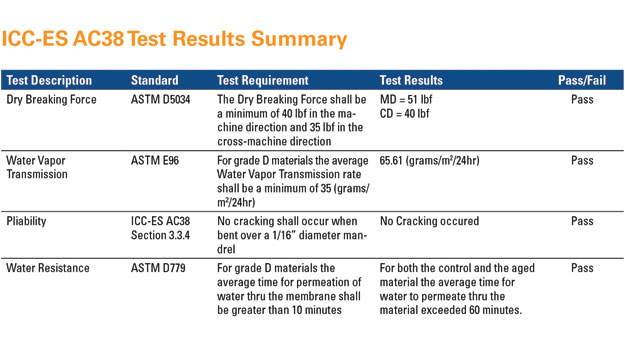Effective and Affordable House Wraps
Durability, Pliability, and UV Resistance
A function of strength, pliability, and UV resistance, durability of a house wrap product is measured through the following tests.
ASTM D5034. Tests to determine a material's strength and tear resistance are important for house wraps, some of which rip and tear easily in handling and application during construction, or by contact with construction debris or high winds, or are susceptible to abrasions and punctures, and snags on tools and nails. A commonly used test to determine the breaking strength and elongation of woven, nonwoven, and felted fabrics and textiles is ASTM D5034, or what is known as the “grab test.” The test fabric is placed in a machine that is designed to measure the force required to tear it. The standard specifies that the Dry Breaking Force shall be a minimum of 40 lbf in the machine direction and 35 lbf in the cross-machine direction, though architects can expect newer products to score as high as 51 lbf in the machine direction, and 40 lbf in the cross-machine direction.

Table courtesy of Kimberly-Clark
This table indicates what a textured house wrap could be expected to achieve compared to the minimum standard required by various industry tests.
AC38 Section 3.3.4. Cold weather construction is a fact of life in many climate zones. Ideally, house wraps retain their pliability even in cold weather applications, and can be easily installed around corners and edges, at joints, and over complex architectural features even when the thermometer dips toward the freezing level. AC38 Section 3.3.4, also known as the Cold Mandrel Bend Test, will determine whether the material will crack at low temperatures. A sample of the test materials is conditioned to 32°F and then bent over a 1/16-inch-diameter mandrel. To conform to this standard, there should be no cracking of the material under test conditions.
UV stability also contributes to a house wrap's durability as small amounts of UV exposure can cause deterioration. Depending on the construction schedule and how long the period between wrapping the house and installing the siding, architects may want to consider products with UV inhibitors, which can minimize this pitfall. Manufacturers generally provide an exposure rating for their product based on days. A UV rating of 60 days is considered a minimum, with 180 days being premium. Prolonged exposure of the house wrap can also subject it to tears from wind, and cause dirt and grime to stain the surface, all of which will compromise the material's intended performance. Fraying, shredding, or coming loose from the siding will also negatively affect the performance of the house wrap, which may then have to be replaced.
Resistance to surfactants, or surface-active contaminants, will also affect the service life of a house wrap. Naturally occurring in materials like cedar and stucco, surfactants decrease water's surface tension so that it can flow more easily through the house wrap which, over time, becomes compromised, and allows water penetration further into the wall cavity and puts the sheathing at risk for water damage. Surfactant contamination risk can be minimized by house wraps designed with anti-surfactant coatings or with drainable house wraps, which quickly move water away from the wall cavity and outside the structure.
Water Resistance and Drainage
In ASTM D779, also known as the Boat Test, a small sample of the test material is folded and placed in a bowl of water. The time it takes for water to pass into the boat is noted. To be certified as a Grade D wrap the time elapsed must be at least 10 minutes. Textured house wraps can exceed this figure significantly, achieving a 60-minute rating.
A house wrap's drainage capacity is measured by the ASTM E2273 Drainage Test. Assuming that some water will invariably infiltrate behind the cladding, the question becomes how quickly it will be able to drain out. Naturally not all products drain at the same rate. This is the subject of ASTM E2273 Standard Test Method for Determining the Drainage Efficiency of Exterior Insulation and Finish Systems (EIFS) Clad Wall Assemblies, the industry standard in measuring the drainage capacity of wall assemblies. Essentially, the test cuts a slot in the cladding into which water is sprayed at a prescribed rate for a prescribed amount of time, approximately 1.7 gallons an hour for 1 hour and 15 minutes. Once the spray ceases, the test determines the percentage of water that drains out the bottom of the wall for one hour. A minimum drainage rate of 90 percent is considered adequate when the product is evaluated in accordance with ASTM E 2273. However, architects should be aware that some of the newer WRB products have achieved as high as a 98 percent drainage rate as measured by this standard.
Permeability
The test that measures the amount of water vapor that passes through a material over 24 hours is ASTM E96. Current building codes require a house wrap to match or exceed Grade D building paper, which has a perm rating of about 5.0. According to the standard, for grade D materials, the average water vapor transmission rate should be a minimum of 35 (grams/m2/24hr). Textured house wraps have achieved a significantly higher rate of 65.61 (grams/m2/24hr), and a perm rating of 10.0 or more.
ASTM E2178 Air Permeance of Building Materials is another applicable test. According to ASTM, “This test method is to determine the air permeance of building materials at various pressure differentials with the intent of determining an assigned air permeance rate of the material at the reference pressure difference (ΔP) of 75 Pa.”4 Test specimens are cut from the sampled material and conditioned for a minimum of 7 days at 21 ± 1°C and 40 ± 5% relative humidity. The specimens are then individually mounted on a test chamber and the airflow through each specimen determined in accordance with ASTM E 2178-03.









